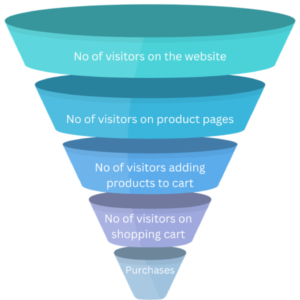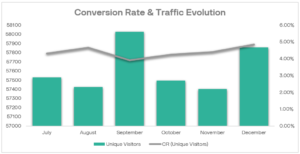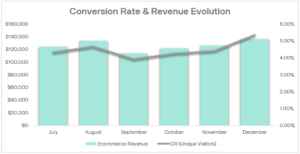Conversion rate is one of the most important key performance indicators (KPI) used by both marketers and business people. Monitoring the conversion rate is crucial for decision-making, especially for businesses selling products online. Moreover, the success of marketing campaigns and marketing budget allocation is also determined by this metric. For this reason, it is very important that you define your conversion properly, considering your business goals, and that you monitor its evolution closely.
How to define conversions
There are different actions that can be tracked as a conversion, depending on the particularities of the business and of the website. For example, for eCommerce businesses, a conversion can be a completed purchase. The conversion will also have a monetary value linked to it, which will be the value of the purchase.
There are businesses selling highly customized services that require initial meetings with company representatives. In this case, a website form completion requesting a meeting with a salesperson could be counted as a conversion. For other businesses, content downloads could be recorded as conversions – when the user downloads valuable content, such as eBooks, whitepapers, after giving their contact information. If the business is a publisher or a blog, newsletter signups could be considered conversions. The important thing is to find an action on the website that aligns with your business objectives and helps you measure the completion of those objectives.

Conversions vs. microconversions
Another aspect to consider is the microconversions, which are smaller, intermediate actions that a visitor can take on a website or app. Those might not necessarily lead to the completion of a primary conversion (the primary goal, such a making a purchase), however, they can indicate user engagement and could show if users are progressing through the purchase funnel. Tracking microconversions is valuable because they can help the business observe user behavior, identify areas of improvement, and optimize the user journey. By optimizing to increase the number of microconversions, you can improve the overall user experience on the website or app and lead more visitors towards completing your primary conversion.
Example of actions that could be treated as microconversions, depending on the business are:
- account creations
- product views
- adding items to cart or wishlist
- social shares
- downloading resources
- engagement with interactive elements such as surveys or quotation calculators
- click-through rates on important website call-to-action buttons
- scroll depth or time spent on site for content-heavy websites.
How to calculate conversion rate
Conversion rate is a value that shows the percentage of website or app visitors that make a purchase or take a desired action on that website or app. The mathematical formula for calculating conversion rate is dividing the number of conversions in each period of time to the number of unique visitors within that same period and multiplying it by 100 to get a percentage.
Conversion rate mathematical formula:

In this scenario, the visitor is a user who viewed the website and the conversions are relevant actions completed. For example, if an eCommerce website received 100 visitors in September and had 30 purchases recorded, then the conversion rate would be 30%.
If you have a high number of returning visitors to your website who are making multiple purchases, you can also choose to calculate conversion rate based on visits/sessions instead of visitors. In this case, the number of conversions will be divided by the number of visits/ sessions of a website in each timeframe and the result will be multiplied by 100.
Measuring and monitoring conversion rate at various levels
It is critical that you monitor your conversion rate at various levels, to make sure that your website and your marketing campaigns are being optimized.
The following areas are important to consider when monitoring conversion rate:
- Conversion Rate at Marketing Campaign Level – Measuring conversion rates at the marketing campaign level allows you to assess the overall performance of your marketing initiatives, whether it is email marketing, social media advertising, pay-per-click (PPC) campaigns, or other advertising efforts.
You can measure campaign conversion rate by diving the number of conversions from a campaign by the number of website visitors coming from the same campaign and multiply the result by 100. Alternatively, you can also calculate by dividing the number of conversions by the number of visitors that saw an ad from a specific campaign.
It is important to differentiate between awareness campaigns that could have the goal of generating impressions or bringing more traffic to your website and conversion campaigns that target prospects that are likely to progress through the purchase funnel. While awareness campaigns might generate conversions as well, this is not their end goal, and the assessment of their performance should not be focused on this metric.
- Conversion Rate at Landing Page Level – Landing pages play a critical role in converting users into leads or customers. Measuring conversion rate at this level can help you determine the effectiveness of your page design and content.
You can measure conversion rate by dividing the number of conversions done by visitors of that landing page by the total number of visitors on the landing page and multiply the result by 100.
- Conversion Rate at Product Level – Understanding how well each product converts can help you make informed decisions about pricing, promotions, and product placement. Conversion rate might differ at product level, and it is important to know the trends for the products in your portfolio. For software businesses, products with a short subscription term of one month might have a higher conversion rate, compared to a 24-month subscription, which requires the shopper to make a more high-commitment decision.
You can measure conversion rate at product level by dividing the number of conversions for a specific product by the number of visitors on the product page and multiplying everything by 100.
- Conversion Rate at Shopping Cart Level – By paying attention to this level of conversion tracking, you can create a more efficient and profitable online shopping experience for your customers. You can measure the conversion rate of the shopping cart by dividing the number of conversions by the number of visitors that accessed the shopping cart and multiplying the result by 100.
You can investigate opportunities for optimization, such as simplifying checkout forms, ensuring clear display of prices, promotions, shipping, and taxes, or add security badges to increase trust, then test the impact those changes have on the cart conversion rate.
Bonus: You can find out more about optimizing conversion rate from experts in the field by accessing our CRO Knowledge Repository on our website.
- Conversion Rate at Country Level – Monitoring this metric at country level allows you to gain insights into how your website or marketing efforts are performing in different geographic regions and can help you develop localization and marketing strategies. You might choose to optimize and display different visuals and messaging on your website depending on the visitor’s country and observe if conversion rate improves.
For eCommerce business, you can choose to optimize your shopping cart depending on the country. For example, buyers from certain countries prefer a shorter checkout flow, while others prefer one that includes reviewing the order details before completing the payment.
You can measure conversion rate at country level by dividing the number of conversions by the number of visitors on the website coming from a certain country and multiplying by 100.
Conversion rate metric chart
To easily monitor conversion rate, it is best to have metric charts prepared. This way, you will have a graphic representation that can easily be interpreted.
One of the charts most used and easiest to understand is a funnel graph that shows the progress of the visitor from the point they enter the website or app, to the moment they make the conversion. For an eCommerce website, this could mean showing a chart displaying how many visitors you had on the website; followed by how many visitors accessed the product pages; then those who added products to the shopping cart; followed by opening the shopping cart, starting the checkout process, and getting to the order review page; and, finally, how many completed a purchase. In this case, you could use the funnel in the example below.

Conversion rate is one of the most important metrics when assessing a website or app, however it should always be monitored in conjunction to other metrics, such as traffic and revenue. For example, if you observe a decrease in conversion rate and an increase in traffic, you could be receiving more unqualified traffic from a specific source and should look into that. It might be a new campaign that is underperforming and could be further optimized. For this reason, it would be useful to have a graph that shows conversion rate in relation to traffic, such as the example below.

For eCommerce businesses, it is essential to observe conversion rate in relation to the revenue generated. Each purchase will have a value that can be recorded in the tracking tools. This way, each conversion defined as purchase will have a monetary value. If we sum up the values for each conversion, we will have the total revenue.
Sometimes you might notice that although the conversion rate has increased, revenue did not increase at the same rate. By analyzing further, you might discover that you only have more purchases for lower priced products and could start researching ways to increase your average order value.

Now that you know how to calculate conversion rate, measuring it at various levels of your website and marketing campaigns will be essential for taking data-driven decisions. Continuous conversion rate monitorization is a fundamental practice in digital marketing and website optimization that can lead to improved ROI and overall growth for your business.
- SEO Powered Content & PR Distribution. Get Amplified Today.
- PlatoData.Network Vertical Generative Ai. Empower Yourself. Access Here.
- PlatoAiStream. Web3 Intelligence. Knowledge Amplified. Access Here.
- PlatoESG. Carbon, CleanTech, Energy, Environment, Solar, Waste Management. Access Here.
- PlatoHealth. Biotech and Clinical Trials Intelligence. Access Here.
- Source: https://blog.2checkout.com/how-to-define-and-measure-conversion-rate/



